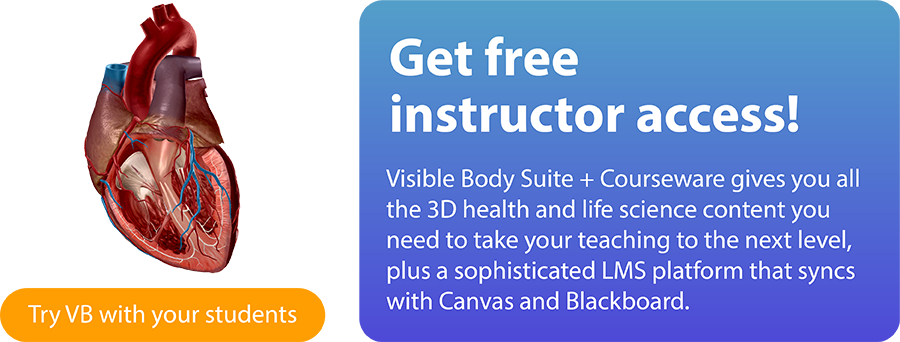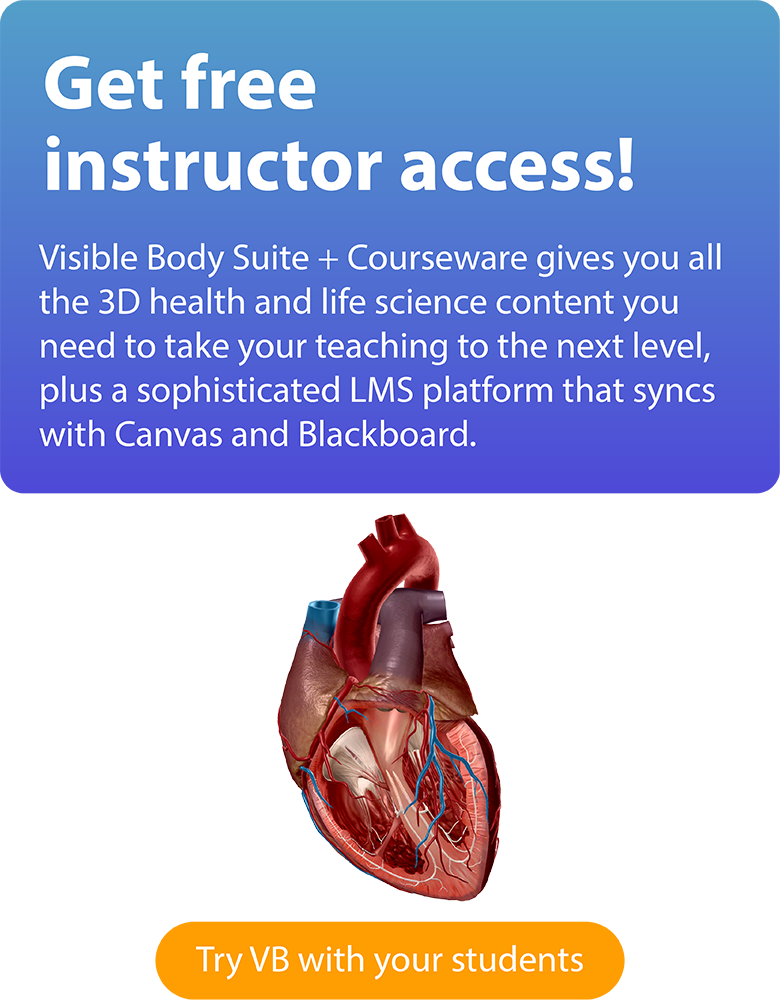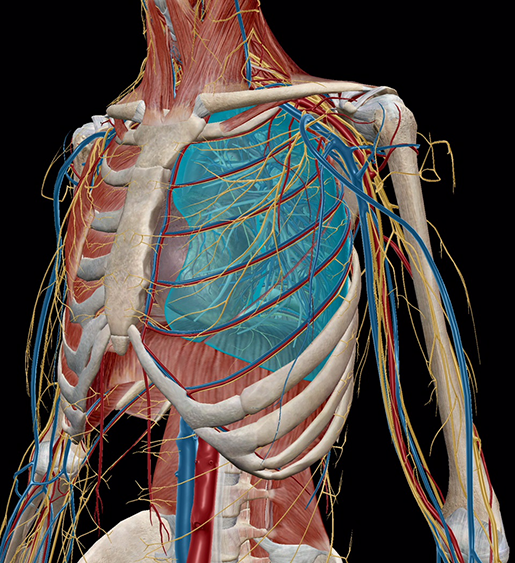Anatomy and Physiology: The Relationships of the Respiratory System
Posted on 11/16/12 by Courtney Smith
Click the play button to listen to an audio version of this blog post!
Place your hand over your chest, take a deep breath, and then let it out.


Of course you already know that your lungs fill with air when you breathe, but did you know that your respiratory system does more than simply move oxygen into and out of your lungs? The structures of the respiratory system interact with structures of the skeletal, circulatory, and muscular systems to help you smell, speak, and move oxygen into your bloodstream and waste out of it.
 Image from Human Anatomy Atlas.
Image from Human Anatomy Atlas.
We're going to take a look at the relationships between these systems and how they work to keep you breathing 24/7/365.
The Lungs of the Respiratory System
The lungs are asymmetrical, conical in shape, and have a spongy texture. If you look in the image below, you'll see a treelike structure in each lung. This structure is the respiratory tree; bronchi—air pathways in the lungs—branch into smaller and smaller bronchioles, each ending in millions of air sacs known as alveoli, where gas exchange occurs. Gas exchange is the conversion of oxygen (what you inhale) into carbon dioxide (what you exhale).
 Image from Human Anatomy Atlas.
Image from Human Anatomy Atlas.
Did you know the surface area of one lung is 750 sq. feet? That is the size of a singles tennis court!
Air flows from the trachea into the bronchi, and from there into the bronchioles of the lungs. The image on the right shows the lungs from a posterior view. The shallow angle of the right primary bronchus is important, because when food accidentally moves down the trachea instead of the esophagus, it’s much more likely to end up in the right lung.
Respiratory System and the Skeleton
The skeletal system provides structure to soft tissue in the upper respiratory tract. The perpendicular plate of the ethmoid (the long section, shown in blue) separates the nasal cavity into sides. The perpendicular plate is one of the structures that help form the nasal septum.
 Image from Human Anatomy Atlas.
Image from Human Anatomy Atlas.
Respiratory System and the Laryngeal Skeleton
Did you know that you're able to produce sounds because of the air you breathe? It's true! In the laryngeal skeleton (a structure comprised of cartilage in the throat area) are the true vocal folds, or vocal cords, which allow you to speak. When air passes over the folds, they vibrate, and it is these vibrations that others (and yourself!) hear as sound.
 Image from Human Anatomy Atlas.
Image from Human Anatomy Atlas.
Here's a cool little factoid: The sinuses in the skull, the thickness of the vocal folds, and the resonance area of the throat give each person’s voice its own character. While people have similar body structures, no two people are completely alike, which also is true for distinct voices.
Respiratory System and the Nerves
Ever wonder how you're able to smell something yummy and recognize it? The respiratory and nervous systems work together to identify odors in your environment. The cribiform plate of the ethmoid bone supports the olfactory bulb and the foramina in the ethmoid give passage to branches of the olfactory nerves.

Image from Human Anatomy Atlas.
Respiratory System and the Circulatory System

Image from Human Anatomy Atlas.
I know I've mentioned the role that blood plays in your body at some point. To recap, blood is the fuel that keeps you going! Oxygenated blood is brought to organs and tissues via the arteries, while veins bring deoxygenated blood back to the heart to be replenished. The point is, without the respiratory system your blood would be useless.
The circulatory and respiratory systems work together to circulate blood and oxygen throughout the body. Air moves in and out of the lungs through the trachea, bronchi, and bronchioles. Blood moves in and out of the lungs through the pulmonary arteries and veins that connect to the heart.
The pulmonary vessels operate backwards from the rest of the body's vasculature: The pulmonary arteries carry deoxygenated blood from the heart to the lungs, and the pulmonary veins carry oxygenated blood back to the heart to be distributed to the body.
Respiratory System and the Muscles of Inhalation and Exhalation
The muscular and nervous systems enable the involuntary breathing mechanism. The main muscles in inhalation and exhalation are the diaphragm and the intercostals (shown in blue), as well as other muscles.
Exhalation is a passive action, as the lungs recoil and shrink when the muscles relax.
 Image from Human Anatomy Atlas.
Image from Human Anatomy Atlas.
Respiratory System Pathologies
As we leave autumn behind and move into the winter months, respiratory infections will become more prevalent. Bronchitis, one of the most common respiratory infections, is inflammation of the bronchi.
Asthma also occurs in the bronchi and can happen all year; it causes the airways of the lungs to swell and narrow, leading to coughing and shortness of breath.
To view a 3D Tour of the images in this blog post using Human Anatomy Atlas 2021 or later...
- Copy this link: https://apps.visiblebody.com/share/?p=vbhaa&t=4_1074_637333540622806870_453113
- Use the Share Link button in the app.
- Paste the link to view the tour.
Be sure to subscribe to the Visible Body Blog for more anatomy awesomeness!
Are you a professor (or know someone who is)? We have awesome visuals and resources for your anatomy and physiology course! Learn more here.
Related Posts:
- Anatomy & Physiology: The Upper Respiratory System
- Anatomy & Physiology: Phonation and the Larynx
- Anatomy & Physiology: Gas Exchange
Additional Sources:
- Notter, Robert H. (2000). Lung surfactants: basic science and clinical applications. New York, N.Y: Marcel Dekker. pp. 120. ISBN 0-8247-0401-0. Retrieved 2008-10-11.
- Parker, S. (2007). The Human Body Book. New York: DK Pub.
- "British Guideline on the Management of Asthma" (PDF). British Thoracic Society. 2009.







